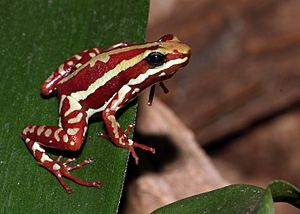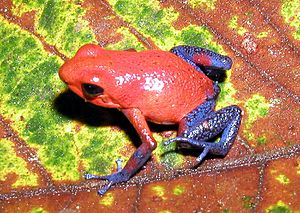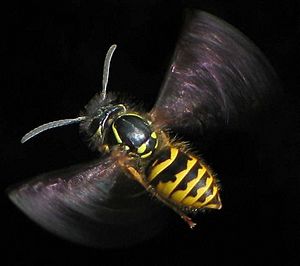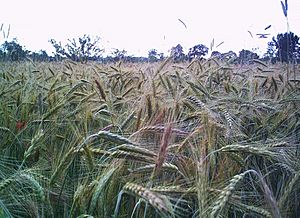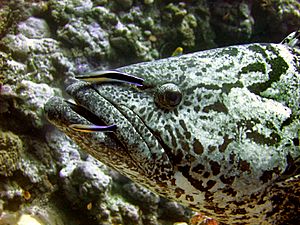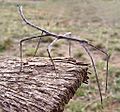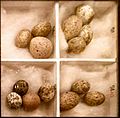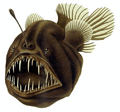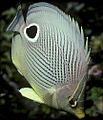Mimicry facts for kids
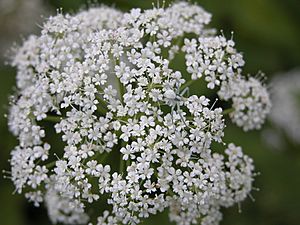
In biology, mimicry is when one species evolves to look or act like another. This helps protect one or both species because a third species cannot tell them apart. Often, animals use their sight for mimicry, looking like another species. But similarities in sound, smell, and behavior can also make the trick seem more real.
Mimicry is like camouflage and warning signals. Species use these to trick or confuse other species that might harm them. Mimicry is mostly a way to defend against predators. But sometimes predators also use mimicry to fool their prey into feeling safe.
Mimicry happens in both animal and plant species. The mimic is the species that looks like the model. The model can be a living thing or something non-living. Many groups of animals use mimicry as a way of life, such as mantids, leaf insects, or stick insects. Camouflage, where an animal looks like its surroundings, is a type of visual mimicry.
There are many more insect mimics than any other animal class. This is because insects make up about 75% of all known animal species. Many other animals also use mimicry, including fish, plants, and even fungi. However, less research has been done on these.
Mimicry evolves because species that are better at mimicking survive. They then have more babies than those that are not as good at mimicking. The genes of the better mimics become more common in the species. Over time, mimic species become more and more like their models. This is the process of evolution through natural selection.
Contents
Staying Hidden: Camouflage
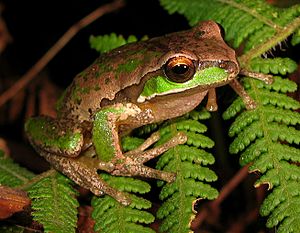
Most higher animals have good eyesight. They use it to find what they want. Both herbivores (animals that eat plants) and predators (animals that hunt and eat other animals) use sight to find food. Prey need to avoid being eaten by predators. Their best chance is to avoid being seen. They usually need camouflage. With camouflage, an animal looks like its background, making it harder to see. Animals achieve this in different ways:
- Matching the background: By colour and shape.
- Disruptive coloration: Patterns that break up the body outline.
- Countershading: Makes the animal look flat. Most animals have a dark back and a light underside. This is countershading. It cancels out the normal effect of light from above, making the body shape less visible.
- Transparency and silvering: Mostly found in animals living in water.
How Behavior Helps
Both camouflage and mimicry work best when a predator is searching from far away. When the predator gets close, and the prey is sure to be found, some prey change tactics. They might flee (run away) or fight back. This behavior is almost always instinctive.
Whether an animal is hidden or not, its behavior must match its mimicry. If it looks like a leaf twisting in the wind, then it must twist in the wind. Almost all types of mimicry involve the right behavior to make the visual trick stronger.
Showing Off: Warning Colors
Not all animals use camouflage. There are times when it is good to show themselves off. One example is when they need to find a mate. Many male animals have bright colors during mating season. Or they change their behavior and come out into the open. Without this, they might not find a mate. Their females, however, are usually dull and camouflaged. This happens in almost all animals where the male displays and the female chooses.
There is a good reason why the female stays camouflaged. Once she is fertilized, she carries the precious eggs. These eggs will become the next generation.
Warning Coloration
Animals that are dangerous or taste bad usually show this clearly. This is called warning or aposematic coloration. It is the opposite of camouflage. Warning colors are bright, often using black, white, red, and yellow.
Tests show that warning colors definitely stop predators. Some individual animals might die or get hurt while predators learn about the link between color and taste. But if warning costs less than hiding, the animal benefits. Also, warning traits like colors can have other uses. For example, the patterns might help animals of the same species recognize each other for mating.
The fact that some animals are truly dangerous or disgusting to eat creates a chance for mimicry based on warning colors. These are called Müllerian and Batesian mimicry.
Müllerian Mimicry
In Müllerian mimicry, several species with warning colors start to look like each other. English naturalist Henry Walter Bates first noticed that some bad-tasting butterflies looked alike in 1862. But he did not explain it well. That was left to German naturalist Fritz Müller in 1878. Müller's explanation was simple: Both species benefit from having a common pattern. They share the cost of predators learning about their bad taste. Just one bad experience for a predator might be enough to stop it from eating both species.
The butterflies Bates, Wallace, and Müller watched were brightly colored and slow-moving. They often flew in groups that were easy to see. Despite this, birds avoided them. This is typical of aposematic (warning) coloration. The coloring of some species from the same area was so perfect that even experienced naturalists could not tell them apart while they were flying.
Once collected, it became clear they were not all the same species. Often, they were not even from the same biological families. The similar warning colors of hornets, wasps, and some bees is Müllerian mimicry if they live in the same area. This way, a predator might choose any of them before learning.
Tests show that birds learn what to eat by trying things when they are young. Scientists still study these ideas today.
Batesian Mimicry
In Batesian mimicry, the mimic is like a sheep in wolf's clothing. It looks like something dangerous or disgusting, but it is actually good to eat. As he explored the Amazon valley in the 1850s, Bates collected butterflies. He saw how some harmless butterflies looked like other species that were toxic. Birds avoided them. So the mimics survived even though they were good food. This was the first scientific report of mimicry.
Hoverflies often visit flowers to feed on nectar. They are harmless insects that often mimic wasps and bees. They also fly slowly and unevenly, much like wasps and bees. Often their mimicry is not perfect. You can easily tell them apart once they land. However, even an imperfect mimic might make a bird hesitate, which could save its life.
Biologists still research Batesian and Müllerian mimicry. They study how the models differ in their bad taste. They also look at what happens when the number of mimics compared to models changes. Often, only the female is a mimic. The male looks normal for its genus. Females need more protection, while males need to mate. Another reason is that it cuts the number of mimics in half, making the mimicry more effective. Batesian mimicry might lose its warning effect if there are too many mimics. This is because more young birds would taste them and be encouraged to try again. The benefit of warning goes down if there are more mimics.
This might explain cases like Papilio dardanus. This is an African swallowtail whose females mimic several bad-tasting species from the Danaidae family. Survival is higher when each mimetic form is rare compared to its model. The advantage is likely greater for females because males do not show the mimetic patterns. Sexual selection probably helps keep this difference. Scientists have studied these and other issues for many years.
With these insects, life is split into stages (see complete metamorphosis). The larva is the growth stage, and the adult is the stage for reproduction. The larvae also show camouflage, warning colors, and mimicry. It is the larvae that get the bad-tasting chemicals from the plants they eat. However, larvae do not show differences between male and female because reproduction is not their job.
Mimicry Rings
In tropical countries, field research has shown that many species are involved in mimicry. There are 54 known species of Heliconius butterflies, with over 700 named color forms. There are four (or maybe five) groups of butterflies that include heliconiines and their mimics. These 'mimicry rings' are called tiger, red, blue, and orange for short. Members of each ring often rest together at night. They also fly in similar places and at the same time of year. Mimicry rings include both Müllerian and Batesian mimicry.
Vavilovian Mimicry
Vavilovian mimicry happens in plants. A weed starts to look like a crop plant. It is named after Nikolai Vavilov, a Russian plant breeder who came up with the idea. Before herbicides, people pulled weeds by hand. This has been done for thousands of years. The weeds start to look like the crop because weeders pick the weeds that look most different. Vavilovian mimicry is caused by humans unintentionally choosing certain weeds. The weeds that survive pass on their genes. Slowly, all the weeds look more like the crop plant.
An example is rye, a common plant in the Mediterranean. Rye was originally just a weed growing with wheat and barley. Weeding made it look like the crop. Like wheat, it grew larger seeds and stiffer stalks where the seeds are attached. Rye is a tougher plant than wheat. It can survive in harsher conditions. After becoming a crop like wheat, rye was able to become a crop plant in tough areas, such as hills and mountains.
Aggressive Mimicry

This type of mimicry is quite common. It is like the bible metaphor of the wolf in sheep's clothing. The mimicry works to attract a victim. The victim is then eaten or taken advantage of. Angler fish, insect-eating plants, and the cuckoo are all examples. All these groups are found widely, and there is no doubt that aggressive mimicry is a successful way of life.
The next two examples use another metaphor, that of the siren. The Australian katydid Chlorobalius leucoviridis can attract male cicadas. It does this by copying the specific reply clicks of female cicadas ready to mate. Experiments show that C. leucoviridis can attract males of many cicada species. This happens even though cicada mating signals are unique to each species.
Female fireflies of the genus Photuris make the same light signals that females of other genera use as a mating signal. Further research showed male fireflies from several different genera are attracted to these mimics. They are then caught and eaten. Female signals are based on what they receive from the male. Each female has a set of signals that match the timing and length of the female of the correct species.
Luring is not always needed. A predator might have a big advantage by not being recognized as a predator. They might look like a helpful mutualistic symbiont or a species that is not important to the prey.
Aggressive mimicry can also be used by some parasites to reach their next host. A parasitic trematode (flatworm) lives in the gut of songbirds. Their eggs pass out and are then eaten by a snail that lives in wet places. The eggs grow into larvae inside this second host. Unlike related species, these larvae are brightly colored and can pulsate (throb). A sac full of spores pushes its way into the snail's eye stalks and pulsates quickly. This makes the eye stalk get bigger. It also changes the snail's behavior: the snail moves towards light, which it usually avoids. These things make the sporocysts very easy to see. They are soon eaten by a hungry songbird. The snail then regrows its eye stalks and continues its life cycle.
Cleaner fish are friends to many other species. They are allowed to eat their parasites and dead skin. Some fish even let the cleaner go inside their mouth to hunt these parasites. One species of cleaner, the Bluestreak cleaner wrasse (Labroides dimidiatus), lives in coral reefs in the Indian and Pacific Oceans. Other fish recognize it and let it clean them.
Its imposter, the mimetic Sabre-toothed blenny (Aspidontus taeniatus), also lives in the Indian Ocean. It not only looks like the wrasse in size and color, but it even copies the cleaner's 'dance'. After tricking its prey into letting its guard down, the blenny bites it. It tears off a piece of its fin before swimming away. Fish attacked this way soon learn to tell the mimic from the real cleaner. But because they look so similar, they become much more careful of the real cleaner too. Because victims can tell the difference between enemy and helper, the blennies have evolved to be very similar, even down to regional differences.
Mimicry Within a Species
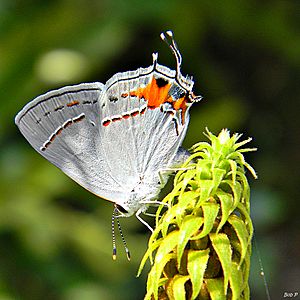
A type of mimicry sometimes called auto-mimicry happens when the model belongs to the same species as the mimic. An example is the Monarch butterfly Danaus plexippus. It feeds on milkweed plants. The butterflies store toxins from the plant, which they keep even as adults. Since the amount of toxin changes based on what they eat as larvae, some Monarchs will be more toxic than others.
Less tasty individuals can be seen as mimics of the more dangerous ones. They have the exact same warning colors as the more toxic individuals. But their punishment for predators is weaker. In species where one sex might be more of a threat than the other, if both sexes look alike, one can protect the other. Evidence came from a monkey in Gabon. It regularly ate male moths of the genus Anaphe. But it quickly stopped after it tasted a bad-tasting female.
False Body Parts
It is common for small prey animals to make their head less visible. Some also make the least important part of their body look like a head. This, like the eye-spots on some butterflies, is a trick to send attacks away. A peck or bite on the false head would just be a small problem. But a peck on the real head would be deadly.
Combined Tricks

Many animals use more than one type of mimicry. This is seen in butterflies. They usually rest with their wings folded upwards. They often have different patterns on the underside of their wings. The underside might be camouflaged, while the upper side has a warning pattern. Moths, which rest with wings horizontal, might have different patterns on their rear wings. The rear wings are normally covered by the front wings when resting. But they can be shown if the moth is disturbed. This trick happens in moths that are active during the day or at twilight. The scarlet tiger moth uses both camouflage and warning color depending on the situation. It is a great example of how behavior and mimicry work together.
Ancient Mimicry
The earliest known example of leaf mimicry among insects was found 165 million years ago in the Middle Jurassic period. The insects are lacewings (Neuroptera). The leaves are from cycads or similar gymnosperms. This is interesting because it shows this type of mimicry evolved long before flowering plants appeared.
Related pages
Examples
-
Mimesis in Ctenomorphodes chronus, camouflaged as a eucalyptus twig.
-
Common hawk-cuckoo looks like a predator, the shikra.
-
Many insects, including hoverflies and the wasp beetle, are Batesian mimics of stinging wasps.
-
The deadly Texas coral snake, Micrurus tener (the mimic).
-
The harmless Mexican milk snake, Lampropeltis triangulum annulata (the model).
-
Brood parasitism: cuckoo eggs (larger) mimic many species of host birds' eggs, in this case, the Eurasian reed warbler's.
-
Pygmy owl (Glaucidium californicum) showing eyespots behind its head.
-
Larva of elephant hawkmoth (Deilephila elpenor, Sphingidae), showing eye-spots when alarmed.
-
Two flatfish blend in! This is dynamic camouflage: it works fast. Their nervous system works on color cells in the skin to match the gravel.
-
Camouflage for an ambush predator: Costa Rican leaf mimic mantis with decay splotch markings.
-
Anglerfish. It tempts prey with the lure hanging above its head, like an angler's bait at the end of his line.
-
The snap traps of the Venus flytrap offer a dummy flower to insects.
Images for kids
-
Eyespots of foureye butterflyfish (Chaetodon capistratus) mimic its own eyes. This sends attacks away from its vulnerable head.
-
Larva of elephant hawkmoth (Deilephila elpenor, Sphingidae), showing eye-spots when alarmed.
See also
 In Spanish: Mimetismo para niños
In Spanish: Mimetismo para niños



